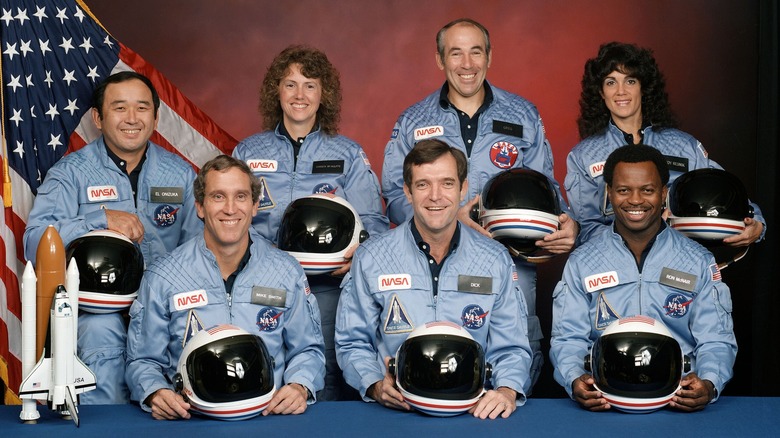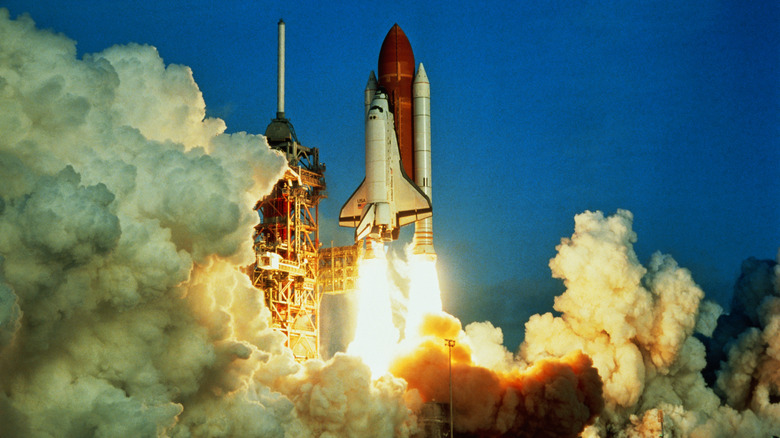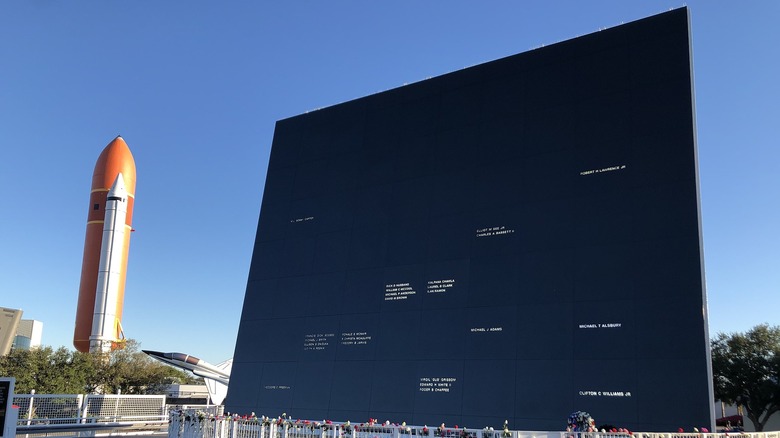What Happened To The Bodies Of The Challenger Crew?
The 1980s was something of a wide-eyed, optimistic period for NASA and space flight. Humans had landed on the moon in 1969 — only 11 years prior at that point — and visions of the future were bold and bright. 1973 saw the European Space Research Organization and NASA agree to develop an orbital space laboratory, 1981 saw the development of the first reusable space shuttle, and the public fully expected to go to Mars and beyond. Then the Challenger disaster happened on January 28, 1986.
While some children tuned in live from school and saw the Challenger shuttle explode 73 seconds after launch, most people watched the taped recording after the fact. The shuttle had set out on a somewhat unglamorous but important mission to set up a Tracking and Data Relay Satellite in orbit and launch a separate satellite to observe Haley's Comet as it swept through our system. Instead, all seven crew members onboard died after their shuttle ignited during launch due to faulty rocket design. Never again would NASA hurry a launch, and never again would excitement trump caution.
Crew members Francis R. "Dick" Scobee, Michael J. Smith, Judith A. Resnik, Ronald E. McNair, Ellison S. Onizuka, Gregory B. Jarvis, and Christa McAuliffe all lost their lives on that day. Divers found their cabin in the Atlantic Ocean on March 9, and it took until April 20 to confirm that the remains on board were theirs. Those remains were eventually cremated and "comingled" at Arlington National Cemetery, where they rest to this day.
A respectful body recovery with few details
The Challenger crew were all smiles before their mission, and happy to the point of jovial as each member spoke a couple words of thanks to everyone present at the launch. In addition to mission specialists, of special note was Christa McAuliffe, the first teacher in space chosen from out of 11,000 applicants. She and the rest of the crew probably lost consciousness due to a change in cabin pressure and died from lack of oxygen before their shuttle hit the water. That being said, it's possible that someone could have woken up during the 2 minutes and 45 seconds that it took to descend to the ocean.
Out of respect officials didn't elaborate on the state of the crew members' bodies when they were recovered. Their cabin was reportedly largely intact, some personal effects floated to the surface of the water, and other research materials were present inside the cabin. Beyond that, the Los Angeles Times quotes a report from NASA saying, "Local security measures are being taken to assure that the recovery operations can take place in a safe and orderly manner," and, "We really don't want to say anything else in deference to the families." However, it's known that the crew's remains were crushed and "could not be recognized as human," as The New York Times wrote at the time.
Body identification was conducted at Patrick Air Force Base Hospital 25 miles from Cape Canaveral by the Armed Forces Institute of Pathology.
Interred at Arlington National Cemetery
As mentioned, the cremated remains of the Challenger crew are interred at Arlington National Cemetery in Virginia. All seven of their remains were mixed and placed together at a memorial in Section 46, Grave 1129, while two of the crew members — Francis R. "Dick" Scobee and Michael J. Smith — also have graves of their own in the cemetery. The memorial features a fitting poem called "High Flight" written by Royal Canadian Air Force pilot John Gillespie Magee Jr. in 1941. In part the poem reads: "Sunward I've climbed, and joined the tumbling mirth / of sun split clouds — and done a hundred things / You have not dreamed of."
Numerous tributes have been written to the Challenger crew over the decades since their death, and there are additional monuments besides the memorial in Arlington National Cemetery that holds the crew's remains. A black granite monument in Montpelier, Vermont was the work of private citizen Danny Roselli, son of the president of a local granite company, who commissioned the memorial shortly after the Challenger disaster. The memorial is small, isolated, and sits off the road. Meanwhile, the Space Mirror Memorial at the Kennedy Space Center in Florida is a grand, but simply designed mirrored surface of polished black granite that reflects the sky. It's currently inscribed with the names of 24 deceased astronauts, including those of the Challenger crew.


